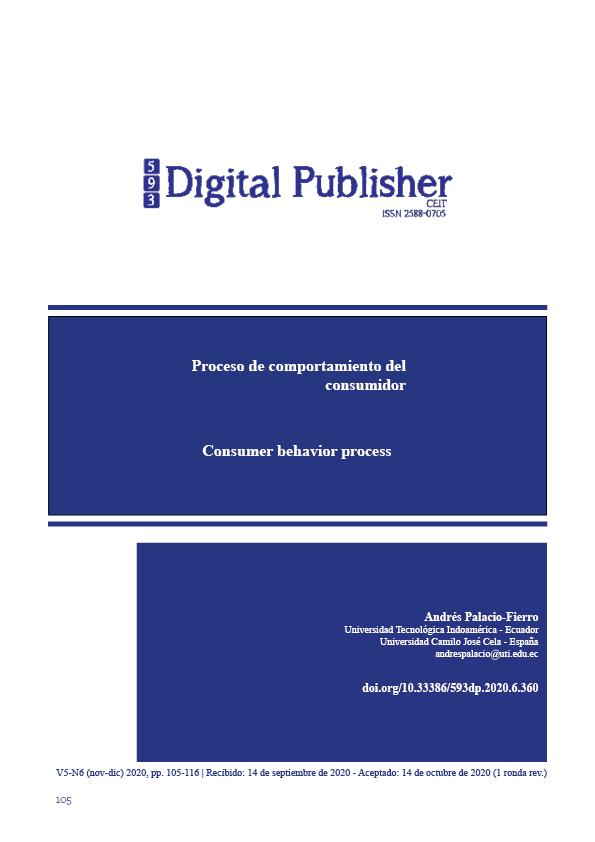Proceso de comportamiento del consumidor
Contenido principal del artículo
Resumen
Los consumidores suelen ser los decisores para aceptar o no los productos que ofertan las empresas. Así, la supervivencia misma de los negocios podría depender de ellos. En consecuencia, si los ejecutivos desarrollan estrategias de marketing sin considerar al consumidor, arriesgan todo lo que han invertido. Por tanto, el objetivo de este artículo es describir los elementos del proceso de comportamiento del consumidor. La metodología utilizada fue la revisión teórica. En la sección de desarrollo de este artículo se presenta las influencias externas (factores de marketing y socioculturales), factores psicológicos, reconocimiento de una necesidad, búsqueda previa a la compra, evaluación de alternativas, comportamiento posterior a la decisión y evaluación posterior a la compra. La principal conclusión que se extrae de esta investigación es la necesidad de que las empresas conozcan las necesidades de comportamiento del consumidor, para lograr este objetivo es necesario aproximarse desde diferentes puntos de vista y áreas de estudio, como el económico, el psicológico, el sociológico y el antropológico.
Descargas
Detalles del artículo

Esta obra está bajo una licencia internacional Creative Commons Atribución-NoComercial-CompartirIgual 4.0.
1. Derechos de autor
Las obras que se publican en 593 Digital Publisher CEIT están sujetas a los siguientes términos:
1.1. 593 Digital Publisher CEIT, conserva los derechos patrimoniales (copyright) de las obras publicadas, favorece y permite la reutilización de las mismas bajo la licencia Licencia Creative Commons 4.0 de Reconocimiento-NoComercial-CompartirIgual 4.0, por lo cual se pueden copiar, usar, difundir, transmitir y exponer públicamente, siempre que:
1.1.a. Se cite la autoría y fuente original de su publicación (revista, editorial, URL).
1.1.b. No se usen para fines comerciales u onerosos.
1.1.c. Se mencione la existencia y especificaciones de esta licencia de uso.
Citas
Alonso Rivas, J., & Grande Esteban, I. (2017). Comportamiento del consumidor. Decisiones y estrategias de marketing (Octava ed.). ESIC.
Amin, M., Isa, Z., & Fontaine, R. (2013). Islamic banks contrasting the drivers of customer satisfaction on image, trust, and loyalty of Muslim and non-Muslim customers in Malaysia. International Journal of Bank Marketing, 31(2), 79-97. doi:https://doi.org/10.1108/02652321311298627
Arli, D., & Tjiptono, F. (2014). The end of religion? Examinig the role of religiousness, materialism, and Long-Term orientation on consumer ethics in Indonesia. Journal of Business Ethics, 123(3), 348-365.
Brakus, J. J., Schmitt, B. H., & Zarantonello, L. (2009). Brand experience: what is it? How is it measured? Does it affect loyalty? Journal of Marketing, 73(3), 52-68.
Broniarczyk, S. M., & Griffin, J. G. (2014). Decision difficulty in the age of consumer empowerment. Journal of Consumer Psychology, 24(4), 608-625.
Cleveland, M., Laroche, M., & Hallab, R. (2013). Globalization, culture, religion and values: comparing consumption patterns of Lebanese Muslims and Christians. Journal of Business Research, 66(8), 958-967.
Clow, K. E., & Baack, D. (2010). Publicidad, promoción y comunicación integral en marketing (Cuarta ed.). México: Pretince Hall.
Coleman, R. (1983). The Continuing Significance of Social Class to Marketing. Journal of Consumer Research, 265-280.
Corona Vázquez, G. (2012). Comportamiento del Consumidor. México: Red Tercer Milenio. OK
Creatibo. (2020). Branding. Obtenido de https://arrontesybarrera.com/creatibo/disonancia-post-compra-que-es-como-evitarla/
De Mooij, M. (2011). Consumer Behavior and Culture (Second ed.). Thousand Oaks: SAGE.
Demangeot, C., Broderick, A. J., & Samuel Craig, C. (2015). Multicultural marketplaces: new territory for international marketing and consumer research. International Marketing Review, 32(2), 118-140.
Dowling, G., & Staelin, R. (1994). A model of perceived risk and intended risk-handling activity. Journal of Consumer Research, 21(1), 119-134.
Drucker, P. F. (1973). Management: Taks, responsabilities, practices. New York: Harper & Row.
Eloisa Bertol, K., Liebesny Broilo, P., & Balestrin Espartel, L. (2017). Young children´s influence on family behavior. Qualitative Market Research: An International Journal, 20(4), 452-468. doi:10.1108/QMR-07-2016-0057
Fall Diallo, M., & Ribamar Siqueira Jr, J. (2015). How previous positive experiences with store brands affect purchase intention in emerging countries. International Marketing Review, 34(4), 536-568. doi:10.1108/IMR-07-2014-0224
Ferrell, O., & Hartline, M. (2017). Estrategia de Marketing. Boston: Cengage Learning.
Fischer, L., & Espejo, J. (2004). Mercadotecnia (Tercera ed.). México: McGraw-Hill.
Fisher, L., & Espejo, J. (2011). Mercadotecnia (Cuarta ed.). México: Mc Graw Hill.
Harcar, T., Spillan, J. E., & Kucukemiroglu, O. (2005). A Multi-National Study of Family Decision-making. The Multinational Business Review, 13(2), 3-21.
Hawkins, D. I., Best, R., & Coney. (2004). Consumer Behavior: Building Marketing Strategy. Boston: McGraw Hill.
Heinrichs, J. H., Lim, J. S., & Lim, K. S. (2011). Influence of social networking site and user access method on social media evaluation. Journal of Consumer Behavior, 10(1), 347-355.
Hofstede, G. (1980). Culture’s Consequences: International Differences in Work-Related Values. Beverly Hills: Sage.
Jani, D., & Han, H. (2014). Personality, satisfaction, image, ambience, and loyalty: testing their relationships in the hotel industry. International Journal of Hospitality, 37(1), 11-20. doi:https://doi:10.1016/j.ijhm.2013.10.007
Kim, Y., & Jeong, J. S. (2015). Pesonality predictors for the use of multiple internet funcions. Internet Research, 25(3), 399-415. doi:https://doi.org/10.1108/IntR-11-2013-0250
Kinard, B. R., & Hartman, K. B. (2013). Are you eterntained? The impact o brand integration and brand experience in television-related advergames. Journal of Advertising, 42(3), 196-203.
King, R. A., Racherla, P., & Bush, V. (2014). What we know and don’t know about online word-of-mouth: a review and synthesis of literature. Journal of Interactive Marketing, 28(3), 167-183. doi:https://doi.org/10.1016/j.intmar.2014.02.001
Kotler, P., & Armstrong, G. (2012). Marketing (Décimo cuarta ed.). México: Pearson.
Kotler, P., & Lane Keller, K. (2012). Dirección de marketing. México: Pearson.
Kotler, P., Armstrong, G., & Opresnik, M. O. (2018). Principles of Marketing (17 ed.). Harlow: Pearson.
Langat, D., & Oduor, P. (2015). THE EFFECTS OF HOFSTEDE’S DIMENSIONS OF CULTURE ON CONSUMER PURCHASE DECISIONS AMONGST THE KIPSIGIS COMMUNITY: A CASE STUDY OF BOMET COUNTY, KENYA. Journal of Business & Change Management, 2(249-267), 249-267.
Lilien, G. L. (2016). The B2B Knowledge Gap. International Journal of Research in Marketing, 33(3), 543-556. doi:https://doi.org/10.1016/j.ijresmar.2016.01.003
Matute, J., Polo-Redondo, Y., & Utrillas, A. (2016). The influence of EWOM. Online Information Review, 40(7), 1090-1110. doi:https://doi.org/10.1108/OIR-11-2015-0373
McCrae, R. R., & Costa, P. T. (2008). Empirical and theoretical status of the five-factor model of (Vol. 1). Sage Publications.
Palacio-Fierro, A., Guadalupe, J., Mantilla, D. & Revelo-Oña (2018). Utilización de controles, auditorías administrativas y sistemas de gestión de la calidad en las PYMES. CienciAmérica, 7(1), 84-97. http://cienciamerica.uti.edu.ec/openjournal/index.php/uti/article/view/154
Peter, J. P., & Olson, J. C. (2006). Comportamiento del consumidor y estrategia de marketing (Séptima ed.). México: McGraw-Hill.
Piff, P. K., Stancato, D. M., Cöté, S., Mendoza-Denton, R., & Keltner, D. (2012). Higher social class predicts increased unethicl behavior. Proceedings of the National Academy of Sciences, 109(11), 4086-4091.
Ramanathan, U., Subramanian, N., & Parrott, G. (2017). Role of social media in retail network operations and marketing to enhance customer satisfaction. International Journal of Operations, 37(1), 105-123. doi:https://doi.org/10.1108/IJOPM-03-2015-0153 OK
Rambocas, M., Kirpalani, V. M., & Simms, E. (2017). Brand equity and customer behavioral intentions: a mediated moderated model. International Journal of Bank Marketing, 36(1), 19-40. doi:https://doi.org/10.1108/IJBM-09-2016-0139
Ries, A., & Trout, J. (2002). Posicionamiento: la batalla por su mente. México: McGraw-Hill.
Robertson, C., & Suárez Guerrero, C. N. (2009). An empirical test of Peruvian sucultures values. Cross Cultural Management. An International Journal, 16(2), 215-229. doi:10.1108/13527600910953946
Schiffman, L. G., Kanuk, L. L., & Wisenblit, J. (2010). Consumer Behavior (Tenth ed.). New Jersey: Pearson.
Shavitt, S., Jiang, D., & Cho, H. (2016). Stratification and Segmentation: Social Class in Consumer Behavior. Journal of Consumer Psychology. doi:10.1016/j.jcps.2016.08.005
Shavitt, S., Lee, A. Y., & Johnson, T. P. (2008). Cross-cultural consumer psychology. Handbook of Consumer Psychology, 1103-1131. New Jersey: Erlbaum Mahwak.
Sivakumar, K., & Nakata, C. (2001). The stampede toward Hofstede’s framework: avoiding the sample design pit in cross-cultural research. Journal of International Business Studies, 32, 55-74.
Solomon, M. R. (2012). Consumer Behavior (10th ed.). Englewood Cliffs, NJ: Prentice Hall.
Song, S., & Yoo, M. (2016). Jounal of Hospitality and Tourism Technology . 7(1), 84-99. doi:10.1108/JHTT-11-2014-0067
Tojib, D., & Khajehzadeh, S. (2013). The role of meta-perceptions in customer complaining behavior. European Journal of Marketing, 48(7), 1536-1556. doi:10.1108/EJM-11-2012-0638
Ur Rahman, S., Adnan Khan, M., & Iqbal, N. (2018). Motivations and barriers to purchasing online: understanding consumer responses. South Asian Journal of Business Studies, 7(1), 111-128. doi:10.1108/SAJBS-11-2016-0088
Velazquez, E. (2012). Canales de distribución y logística. Tlalnepantla: Red Tercer Milenio.
Zhang, Z., & Hou, Y. (2017). The effect of perceived risk on information search for innovative products and services: the moderating role of innate consumer innovativeness. Journal of Consumer Marketing, 34(3), 241-254. doi:10.1108/JCM-04-2016-1768


